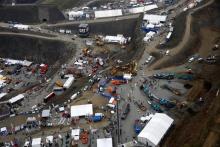The ‘adjustment’ in European construction investment is expected to come to an end in 2015, which should allow it to gather pace in 2016 and 2017, according to the latest
The CECE bulletin, which will provide encouragement to European building materials suppliers, says support for construction investment should mainly come from the relatively strong growth in household real disposable income, low mortgage rates, and a return to rising house prices. However, since these factors will continue to be partially offset in some EU Member States by high levels of household debt and sluggishness in the non-residential construction sector, the rebound in construction investment should be moderate.
According to European Commission figures quoted in the CECE bulletin, the value of construction industry output among the biggest five European markets in 2015 was: Germany € 288.7 billion; France €192 billion; UK €176.8 billion; Italy €162.2 billion; and Spain €66.3 billion.
The CECE bulletin summarises: “All in all, construction investment is expected to increase by 2% and 3.4% in the euro area in 2016 and 2017 respectively, and by 2.4% and 3.7% in the EU, with a contrast between countries due to structural features, the past performance of the construction sector and the current pace of economic recovery. The rebound should be particularly visible in economies that experienced a pre-crisis housing boom, but were then hard hit by the financial crisis (e.g. Ireland, Spain, and the UK) or that are among the faster growing economies in the EU in the post-crisis period (e.g. Germany and Sweden). Ongoing adjustments will continue in 2016 in a number of countries (Greece, France, Slovenia, and Slovakia in the euro area, and Bulgaria, the Czech Republic, and Hungary in the rest of the EU), while in 2017, construction investment is expected to rise in all countries.”
The CECE has a continuous dialogue with European institutions on behalf of the European construction equipment industry, coordinating the views of its national member associations, and working with other organisations worldwide to achieve a fair competitive environment via harmonised standards and regulations.







